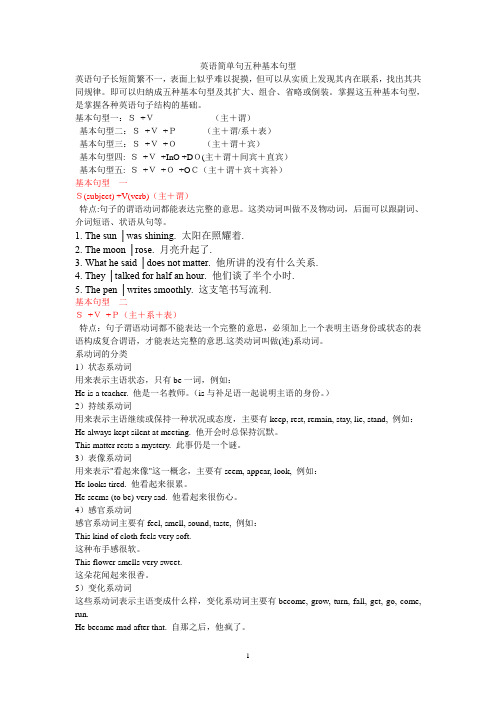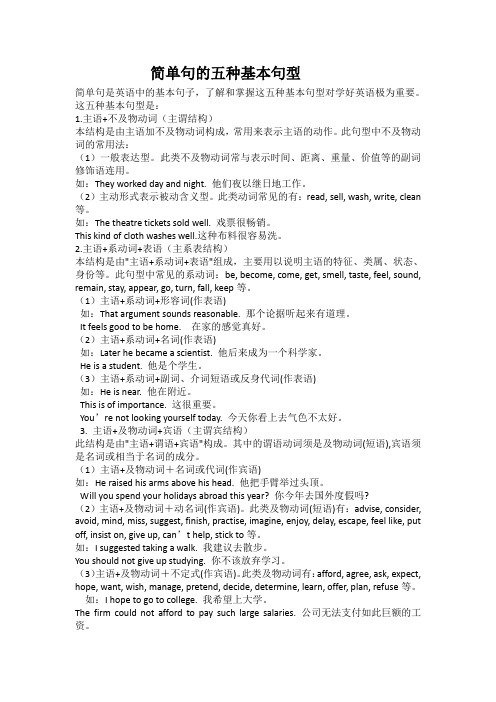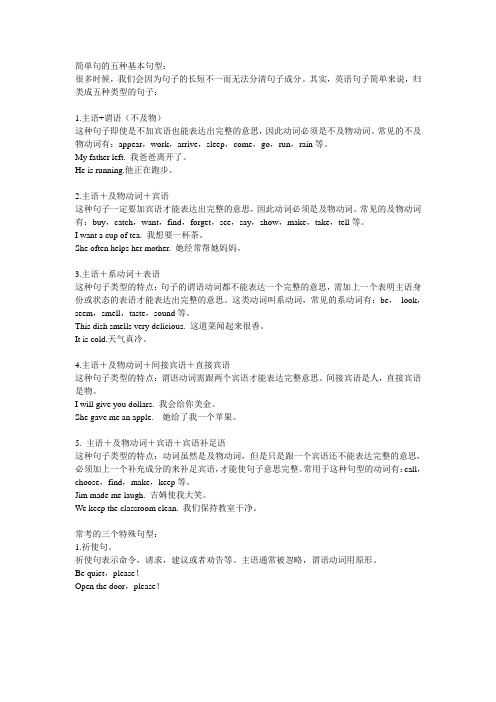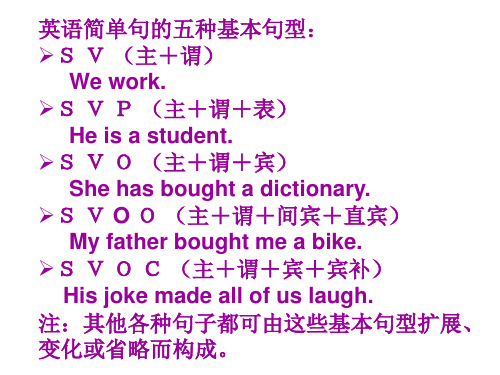英语简单句五大句型
英语简单句五大句型

子有一个共 同特点,即 句子的谓语
She sings beautifully.
动词都能表
2) S + Vi+ prep Phrase(介词短语) 达完整的意
思。
He we43; Vi+ Infinitive (不定式)
做不及物动
We stopped to have a rest.
I feel something moving.
常用于这句型的动词有:catch, feel, find, get, have, hear, keep, leave, notice, see, smell, watch等。
1 I don't know study English. 2 We are don't spent much time playing computer
注意:She brought her boyfriend to the party.
Bring a present for Mary.
You can leave the cooking to me.
Someone left the note for you.
5. S (主)+ vt(谓)+ O(宾) + O C(宾补) 1) S + vt + n./pron + n. We named our baby Tom.
4) S + Vi+ Participle (分词)
词,后面可 以跟副词、 介词短语、
I'll go swimming.
不定式、分
词等。
2. S (主)+ vt (及物动词)(谓)+ O(宾)
英语中的五种基本句型

5.主+谓+宾+宾补
They found the house dirty.
What makes him
sad?
We saw him go out.
He asked me
to come back .
可以接宾补的动词:
call, make, think, find, leave, elect(选举),
2. 在表示心理状态的动词后作宾语补足语。 这类动词有:consider, think, believe, discover, find, imagine, judge, suppose, prove等。这类动词后的不定式通常是"to be+ 形容词或名词"结构,think, consider, find后的to be常可省略。
3. I change you. 主+谓+宾
4.Mother gave me 10 yuan. 主 + 谓 + 间宾 + 直宾
5.You made your father angry. 主 + 谓 + 宾 + 宾补
英语中简单句的五种基本句型如下:
1. 主+谓(vi) (S+V) 2. 主+系+表 ( S+V+P )in 3. 主+谓+宾 (S+V+O) 4. 主+谓+间宾+直宾 (S+V+IO +DO) 5. 主+谓+宾+宾补(S+V +O +OC)
练习一:指出下列句子是什么句型? 1.They work hard. 2.The flower is dead. 3.Plants need water. 4.He gives me some seeds. 5.We should keep the plants in the shade. 6.Many animals live in trees.
英语简单句五种基本句型

英语简单句五种基本句型英语句子长短简繁不一,表面上似乎难以捉摸,但可以从实质上发现其内在联系,找出其共同规律。
即可以归纳成五种基本句型及其扩大、组合、省略或倒装。
掌握这五种基本句型,是掌握各种英语句子结构的基础。
基本句型一:S+V(主+谓)基本句型二:S+V+P(主+谓/系+表)基本句型三:S+V+O(主+谓+宾)基本句型四: S+V+InO +DO(主+谓+间宾+直宾)基本句型五: S+V+O+OC(主+谓+宾+宾补)基本句型一S(subject) +V(verb)(主+谓)特点:句子的谓语动词都能表达完整的意思。
这类动词叫做不及物动词,后面可以跟副词、介词短语、状语从句等。
1. The sun │was shining. 太阳在照耀着.2. The moon │rose. 月亮升起了.3. What he said │does not matter. 他所讲的没有什么关系.4. They │talked for half an hour. 他们谈了半个小时.5. The pen │writes smoothly. 这支笔书写流利.基本句型二S+V+P(主+系+表)特点:句子谓语动词都不能表达一个完整的意思,必须加上一个表明主语身份或状态的表语构成复合谓语,才能表达完整的意思.这类动词叫做(连)系动词。
系动词的分类1)状态系动词用来表示主语状态,只有be一词,例如:He is a teacher. 他是一名教师。
(is与补足语一起说明主语的身份。
)2)持续系动词用来表示主语继续或保持一种状况或态度,主要有keep, rest, remain, stay, lie, stand, 例如:He always kept silent at meeting. 他开会时总保持沉默。
This matter rests a mystery. 此事仍是一个谜。
3)表像系动词用来表示"看起来像"这一概念,主要有seem, appear, look, 例如:He looks tired. 他看起来很累。
简单句的五种基本句型

简单句的五种基本句型简单句是英语中的基本句子,了解和掌握这五种基本句型对学好英语极为重要。
这五种基本句型是:1.主语+不及物动词(主谓结构)本结构是由主语加不及物动词构成,常用来表示主语的动作。
此句型中不及物动词的常用法:(1)一般表达型。
此类不及物动词常与表示时间、距离、重量、价值等的副词修饰语连用。
如:They worked day and night. 他们夜以继日地工作。
(2)主动形式表示被动含义型。
此类动词常见的有:read, sell, wash, write, clean 等。
如:The theatre tickets sold well. 戏票很畅销。
This kind of cloth washes well.这种布料很容易洗。
2.主语+系动词+表语(主系表结构)本结构是由"主语+系动词+表语"组成,主要用以说明主语的特征、类属、状态、身份等。
此句型中常见的系动词:be, become, come, get, smell, taste, feel, sound, remain, stay, appear, go, turn, fall, keep等。
(1)主语+系动词+形容词(作表语)如:That argument sounds reasonable. 那个论据听起来有道理。
It feels good to be home.在家的感觉真好。
(2)主语+系动词+名词(作表语)如:Later he became a scientist. 他后来成为一个科学家。
He is a student. 他是个学生。
(3)主语+系动词+副词、介词短语或反身代词(作表语)如:He is near. 他在附近。
This is of importance. 这很重要。
You’re not looking yourself today. 今天你看上去气色不太好。
3. 主语+及物动词+宾语(主谓宾结构)此结构是由"主语+谓语+宾语"构成。
英语简单句的五种基本句型

8.主语+系动词+形容词+介词短语 She is fond of this country. I was sick of lying in bed. They seem delighted with the result. 9.主语+系动词+形容词+不定式 I’m happy to meet you. She was eager to see her people. 10.主语+系动词+形容词+从句 I’m glad you have come. We’re not clear what they’re up to. I am not certain who he is. He’s doubtful whether he can afford it.
四 主语+系动词+表语
1.主语+系动词+形容词 How are you? I’m fine. He has fallen ill. They kept silent.
2.主语+系动词+名词 His dream has at last become a reality. He appeared a fool. It sounds a good idea.
5.They kept their marriage a secret. 6.He played dead. 7.She was nicknamed “Little Rabbit”. 8.Show me what you bought. 9.She never doubted that she was right. 10.Good food keeps you healthy.
6.主语+及物动词+动名词(做宾语) Would you mind waiting for a few minutes? I prefer standing. I propose resting for half an hour. 7.主语+及物动词+从句 (做宾语) He claimed that he saw the accident. I suggested (that) we (should) leave early. Do you see why I did it? Can you tell which is which? She asked if she might call and see me. I’ll do what I can. I don’t remember when that happened.
简单句的五种基本句型英语

简单句的五种基本句型英语
摘要:
一、简单句的五种基本句型
1.主语+谓语
2.主语+谓语+宾语
3.主语+谓语+宾语+宾语补足语
4.祈使句
5.感叹句
正文:
简单句是英语中最基本的句子结构,它由一个或多个词组成,表达一个完整的意思。
在英语中,有五种基本句型,分别是:
1.主语+谓语(Subject + Predicate)
这种句型用于表达一个简单的行为或状态。
如:“我学习英语。
”在这个句子中,“我”是主语,“学习”是谓语。
2.主语+谓语+宾语(Subject + Predicate + Object)
这种句型用于表达一个行为的主体、动作和对象。
如:“我喜欢苹果。
”在这个句子中,“我”是主语,“喜欢”是谓语,“苹果”是宾语。
3.主语+谓语+宾语+宾语补足语(Subject + Predicate + Object + Complement)
这种句型用于表达一个行为的主体、动作、对象以及对象的状态。
如:“我吃了一个苹果。
”在这个句子中,“我”是主语,“吃”是谓语,“一个苹果”是
宾语,“了”是宾语补足语。
4.祈使句(Imperative Sentence)
祈使句用于表达命令、请求、劝告等。
如:“请打开窗户。
”在这个句子中,没有主语,只有谓语“打开”。
5.感叹句(Exclamatory Sentence)
感叹句用于表达惊喜、惊讶、赞叹等强烈情感。
如:“多么美丽的景色!”在这个句子中,“多么”是感叹词,“美丽”的“景色”是主语和宾语。
以上就是英语简单句的五种基本句型。
英语简单句五大基本句型

五、主语+系动词+表语。 例如“you are my mother”(你是我的妈妈)就是一 个简单的主系表结构。
PART 01
单击添加标题
ANNUAL WORK OVERVIEW
PART 02
单击添加标题
ANNUAL WORK OVERVIEW
PART 03
单击添加标题
ANNUAL WORK OVERVIEW
PART 04
单击添加标题
ANNUAL WORK OVERVIEW
Hale Waihona Puke HANK YOU感谢各位观看
三、主语+谓语+双宾语(直接宾语+间接宾语)。 例如“I can give you an apple”(我可以给你一个苹果 ),其中“you”是跟在动词"give"后面的,为直接宾语 ,“an apple”也是宾语,作为间接宾语。
四、主语+谓语+宾语+宾补 例如:“you make me happy”(你使我快乐),主谓 宾的成分很容易看出,happy作为宾语补足语,补充说明 宾语“me”的状态,使句子更加完整。
简单句五大基本句型
一、主语+谓语 这是英语句子中最基本最简单的句型。 如:西式婚礼中常说的“yes,I do”这里面“I do”就 是最基本的主语+谓语的句型。I是主语,do是谓语。
二、主语+谓语+宾语 这是英语基本句式中应用的最为广泛的一种,它和我们汉语中的主谓 宾表达基本一致。 例如西方表达爱意常用的一句“I love you”。英语中“I love you” 为主谓宾结构,汉语中的“我爱你”也是如此结构。
英语中简单句的五种句型

英语中简单句的五种句型
英语中简单句的五种句型分别是:主语+谓语、主语+谓语+宾语、主语+谓语+表语、主语+谓语+宾语+宾补和主语+谓语+宾语+状语。
以下是这五种句型的详细介绍:
1.主语+谓语:这种句型中的谓语动词是不及物动词,即动词后面不需
要宾语,直接表达动作或状态。
例如:“He smiled. 他笑了。
”2.主语+谓语+宾语:这种句型中的谓语动词是及物动词,即动词后面需
要宾语来表达动作或状态。
例如:“He likes music. 他喜欢音乐。
”
3.主语+谓语+表语:这种句型中的谓语动词是系动词,如“be”、
“seem”、“look”等,后面连接的是表语,通常描述主语的性质或状态。
例如:“He is a teacher. 他是一名老师。
”
4.主语+谓语+宾语+宾补:这种句型中的谓语动词后需要一个宾语和一
个宾补来共同表达完整的动作或状态。
例如:“They elected him president. 他们选举他为总统。
”其中,“president”是宾补,补充说明“他”的身份。
5.主语+谓语+宾语+状语:这种句型中的谓语动词后需要一个宾语和一
个状语来共同表达完整的动作或状态。
例如:“She sings
beautifully. 她唱得很美。
”其中,“beautifully”是状语,修饰“唱”这个动作。
以上就是英语中简单句的五种句型。
英语简单句的五种基本句型

英语简单句的五种基本句型只包含一个主语(或并列主语)和一个谓语(或并列谓语)的句子,称作简单句。
简单句有以下5种基本句型。
1、S主+Vi不及物:Wecome我们来;2、S主+V系+P表:Classisover下课了;3、S主+Vt及物+O宾:Shehateshim她恨他;4、S主+Vt及物+IO间宾+DO直宾:Shegavemeanewbook.他给了我一本新书;5、S主+Vt及物+O宾+OC宾补:WenamedourbabyTom.我们给孩子取名汤姆。
5种基本句型用法详解1、主+谓=S+Vi(主+不及物动词)主语:可以作主语的成分有名词,主格代词,动词不定式,动名词等等。
主语一般在句首。
谓语:谓语由动词构成,是英语时态、语态变化的主角,一般在主语之后。
不及物动词(vi.)没有宾语,形成主谓结构,如:S(主)+Vi(不及物动词)(谓语)Thebabycried.婴儿哭了Wecome.我们来1)S+Vi+副词(状语)eg:Birdssingbeautifully.2)S+Vi+介词短语(状语)eg:Hewentonholiday.3)S+Vi+不定式(状语)eg:Westoppedtohavearest.4)S+Vi+分词(状语)eg:I'llgoswimming.此句型的句子有一个共同特点:即句子的谓语动词都能表达完整的意思。
这类动词叫做不及物动词,后面可以跟副词、介词短语、状语从句等。
2、S+V系+P(主+系+表)此句型的句子有一个共同的特点:句子谓语动词都不能表达一个完整的意思,必须加上一个表明主语身份或状态的表语构成复合谓语,才能表达完整的意思。
这类动词叫做连系动词。
表语也就是主语的补足语ThisisanEnglish-Chinesedictionary.Thedinnersmellsgood.Heisgrowingtallandstrong.1)S+V+名词/代词eg:Heisaboy.2)S+V+形容词eg:Sheisbeautiful.3)S+V+副词eg:Classisover.4)S+V+介词短语eg:Heisingoodhealth.5)S+V+分词eg:Heisexcited.3、S+Vt+O(主+及物+宾)此句型句子的共同特点是:谓语动词都具有实义,都是主语产生的动作,但不能表达完整的意思,必须跟有一个宾语,动作的承受者,才能使意思完整。
英语简单句的五种基本句型

主语 谓语
宾语
宾补
名词、形容词、 非谓语动词、 介词短语等可 作宾语补足语
Language in use: analyze the sentences
• We had better make a career plan. • A career goal may help you discover your talents. • We must first ask ourselves the following questions.
= He sent a letter to me.
常跟介词for: buy; make; do; choose; get; pay 等
常跟介词to: bring; give, hand, pass; lend, owe, offer; post; promise; read; teach; sell; show 等
主语+谓语+宾语+宾语补足语
种类
第1种 第2种 第3种 第4种
第5种
句型
S+V+(A) S+V+P S+V+O S+V+Oi+Od
S+V+O+Oc
谓语部分
S (主语)
V(谓语动词)
P(表语)
O(宾语)
Oc(宾语 补足语)
We
work.(不及物)
He
is(系动词) a student.
You
play(及物)
句型五:主语+谓语+宾语+宾语补足语(S+V+O+Oc)
The doctor advised me to give up smoking.
简单句的五种基本句型

简单句的五种基本句型:很多时候,我们会因为句子的长短不一而无法分清句子成分。
其实,英语句子简单来说,归类成五种类型的句子:1.主语+谓语(不及物)这种句子即使是不加宾语也能表达出完整的意思,因此动词必须是不及物动词。
常见的不及物动词有:appear,work,arrive,sleep,come,go,run,rain等。
My father left. 我爸爸离开了。
He is running.他正在跑步。
2.主语+及物动词+宾语这种句子一定要加宾语才能表达出完整的意思,因此动词必须是及物动词。
常见的及物动词有:buy,catch,want,find,forget,see,say,show,make,take,tell等。
I want a cup of tea. 我想要一杯茶。
She often helps her mother. 她经常帮她妈妈。
3.主语+系动词+表语这种句子类型的特点:句子的谓语动词都不能表达一个完整的意思,需加上一个表明主语身份或状态的表语才能表达出完整的意思。
这类动词叫系动词,常见的系动词有:be,look,seem,smell,taste,sound等。
This dish smells very delicious. 这道菜闻起来很香。
It is cold.天气真冷。
4.主语+及物动词+间接宾语+直接宾语这种句子类型的特点:谓语动词需跟两个宾语才能表达完整意思。
间接宾语是人,直接宾语是物。
I will give you dollars. 我会给你美金。
She gave me an apple. 她给了我一个苹果。
5. 主语+及物动词+宾语+宾语补足语这种句子类型的特点:动词虽然是及物动词,但是只是跟一个宾语还不能表达完整的意思,必须加上一个补充成分的来补足宾语,才能使句子意思完整。
常用于这种句型的动词有:call,choose,find,make,keep等。
Jim made me laugh. 吉姆使我大笑。
英语简单句中五种基本句型

英语简单句中五种基本句型
英语简单句的五种基本句型是:
1. 主语+谓语(不及物动词):S+V
例如:The sun rises. 太阳升起。
2. 主语+谓语(及物动词)+宾语:S+V+O
例如:I like apples. 我喜欢苹果。
3. 主语+谓语+间接宾语+直接宾语:S+V+IO+DO
例如:He gave me a book. 他给了我一本书。
4. 主语+系动词+表语:S+V+P
例如:She is a doctor. 她是一名医生。
5. 主语+谓语+宾语+宾语补足语:S+V+O+OC
例如:We made him our monitor. 我们选他当班长。
需要注意的是,这些句型只是英语简单句的基本结构,实际应用中还有很多复杂的句型和变化。
同时,英语句子的语序和汉语句子的语序也有所不同,需要在学习中逐渐适应。
简单句的五种基本句型

for
do, buy, cook, choose, fetch, get, leave, make, order, paint, play(演奏), save, sing,
基本句型 五
此句型的句子特点是: 动词虽然是及物动词,但是一个 宾语还不能表达完整的意思,须 加上一个补充成分来补足宾语才 能使意思完整。
主+系 +表(S+V+P)
4. Breckenridge hosts the international Snow Sculpture Championships. 主+动 +宾(S+V+O) 5. Our neighbors gave us a baby bird yesterday. 主+动 +间宾 +直宾(S+V+IO+DO) 6. We think it our duty to study well.
基本句型 二
S
1. He
2. The dinner 3 the weather 4. It s;
is
smells Became sounds is
P(主+系+表)
tall and strong.
good. warmer. a good idear in
6.Summer
基本句型 三 S +V +O(主+谓+宾) 此句型句子的共同特点是谓 语动词都具有实义,都是主语产 生的动作,但不能表达完整的意 思,必须跟有一个宾语,即动作 的承受者,才能使意思完整。这 类动词叫做及物动词。
S
V(实义动词)
O(宾语)
1. Who 2. She 3. He 8. He 5. They 6. I 7. He
英语简单句的五种基本句型及Therebe结构

英语简单句的五种基本句型及Therebe结构英语简单句的五种基本句型一、划分句子成分1. They work hard.2. The desk feels hard.3. Plants need water4. He gave me some seeds.5. We should keep the plants in the shade.二、归纳:英语五种基本句型:1.S+V(主+谓)2.S+V+P(主+系+表)3.S+V+O(主+谓+宾)4.S+V+IO +DO (主+谓+间宾+直宾)5.S+V+O+OC(主+谓+宾+宾补)基本句型一:S+V+P(主+系+表)此句型的句子谓语动词不能表达一个完整的意思,必须加上一个表明主语身份或状态的表语构成复合谓语,才能表达完整的意思。
这类动词叫做连系动词。
本结构是由主语+系动词+表语组成。
系动词有:1.表示特征和存在状态的be, seem, feel, appear, look, smell, taste, sound;2.表示状态延续的remain, stay, keep, continue, stand;3.表示状态变化的become, get, turn, go, run, fall, come, grow;练习1:划分句子成分(1).Our English teacher is thirty years old. (2).The cake tastes delicious.(3).We feel used to living in big cities (4).The potatoes went bad in the fields.(5).Their boss seems satisfied with the work. (6).Deep waterstays still.练习21今天我感觉不太舒服。
2 他看上去很累。
3 你的汤味道很好。
4 她似乎对计划不感兴趣。
英语简单句的五种基本句型

红阳高中 刘学志
e-mail xuezhi818141@
五种基本句型
1. 主语+不及物动词 Everybody smiled. 2. 主语+及物动词+宾语 He knows everything. 3. 主语+双宾动词+间接宾语+直接宾语 I showed him my passport. 4. 主语+系动词+表语 The boy looks healthy. 5. 主语+及物动词+宾语+宾语补语 What made you angry?
3.主语+及物动词+同源宾语 He smiled a strange smile. As he slept, he dreamed a dream.
4.主语+成语动词+宾语 He handed in his homework this morning. They are looked down by everyone.
二 主语+及物动词+宾语
1.主语+及物动词+名词(代词) Do you know these thid he say?
2. 主语+及物动词+反身代词 Now I will introduce myself. They blamed themselves for the accident.
3. 主语+不及物动词+副词(构成成语动词) The engine broke down. How did the accident come about? The bomb blew up.
4.主语+不及物动词(有被动意思) Is the book selling well? Does this cloth wash well?
英语简单句的五个基本句型

He is standing by the window.他站在窗户边。
( 助动词+现在分词 )
句型2:主语+谓语 1. 她高兴地跳起来了.
She jumped up with joy. 2. 这些苹果很好卖.
These apples sell well.
sell well表示主语的某种属性特征,用主动表被动。 类似的动词还有write, wash, dry 等。 This pen writes smoothly. Such kind of shirt dries easily.
三)主语+及物动词+宾语+how (who, when, where 等)从句 你能告诉我我们要见谁吗? Can you tell me who(m) we have to see?
基本句型五:主语+及物动词+宾语+宾补
本句型中的动词虽然是及物动词,但是只跟宾语还不能表达完 整的意思,必须加上一个补充成分如名词、形容词、副词(仅限 少数几个)、动词不定式、分词来补充说明宾语,才能表达一个 完整的意思。宾语和宾语补足语在意义上有一种逻辑上的主谓 关系,即宾语与宾语补足语在“意义上”是一种主谓关系。如:
消息我们很兴奋。( 过去分词 ) 6. The book is boring.这本书很泛味。( 现在分词 ) 7. Her dream is to become a teacher.他的梦想是
做教师。( 不定式短语 ) 8. My hobby is collecting coins.我的爱好是收集
硬币。( 动名词 ) 9. The reason for my failure was that I hadn't put
英语简单句五种句型

英语简单句的五种句型1.主语+ 不及物动词(主、谓结构)eg. He is working.2.主语+ 及物动词+ 宾语(主、谓、宾结构)eg. We study English every day.3.主语+ 连系动词+ 表语(主、系、表结构)eg. Trees turn green.常见的连系动词有:be ; become ; get ; turn ; feel ; look(看起来);smell(闻起来); sound(听起来);taste(尝起来);seem(似乎).特别注意:形容词常作表语4.主语+ 及物动词+ 间宾(人)+ 直宾(物)=主语+ 及物动词+ 直宾(物)+ to / for + 间宾(人)常用的此类动词有:give ; pass ; show ; lend ; buy. 但buy与for连用eg.1)I gave him a book.= I gave a book to him.2)My mother bought me a pen yesterday.= My mother bought a pen for me.5.主语+ 及物动词+ 宾语+ 宾补注意作宾补的词:1)名词(指宾语是谁/什么);2)形容词;3)不定式;4)动词的ing 形式。
eg.1)We call him Jim.2)We must keep the window open.3)He told me to wash the plates.4)I saw a thief going into your room.特别注意:1)动词不定式作宾补A: ask / want / tell sb to do sth.其否定式为:ask/want/tell sb not to do sth2)省to不定式作宾补,即:(l, m, n; 3h; 2看; 1f) sb do sthl—let, m—make, n—notice; 3h—hear, have , help; 2看—see, watch; 1f—feel.eg.1)The boss made the workers work 12 hours every day.2)I often hear him sing.2)区别省to不定式作宾补与动词ing形式作宾补.hear / see sb do: 听见/看见某人做了某事hear / see sb doing: 听见/看见某人在做某事。
英语中的五种基本句型

consider(认为), describe, declare(宣称), etc.
什么动词需要接宾语补足语?
1. 感官动词和使役动词,如: see, hear, notice, watch, hear, feel, observe(感官动词) make, have, let, get(使役动词)
2. 在表示心理状态的动词后作宾语补足语。 这类动词有:consider, think, believe, discover, find, imagine, judge, suppose, prove等。这类动词后的不定式通常是"to be+ 形容词或名词"结构,think, consider, find后的to be常可省略。
4.主+谓+间宾+直宾
She passed him a new dress. He bought her nothing. I told him that the bus was late. He showed him how to use the video.
5.主+谓+宾+宾补
They found the house dirty.
如:He became mad after that. 4.状态系动词:keep, remain, stay;
如:This matter remains a mystery.
3:主+谓+宾
They ate cakes.
He said "Good morning."
I
want to have a cup of tea.
6.Many animals live in trees. 主+谓
练习二:翻译下列句子并,写出是五种句型结构中的哪一种。
简单句的五种基本句型

陈述句,疑问句,祈使句,感叹句主动句被动句副词的位置英语句子纷繁复杂,多种多样,但是按照其结构组成的不同,可以划分为三种类型简单句:只有一个主语(或并列主语)和一个谓语(或并列谓语)的句子叫做简单句。
并列句复合句(同位语从句与定语从句的区别)简单句又可分为五大基本句型,这五个基本句式如下S十V 主谓S十V十P 主系表S十V十O 主谓宾S十V十O1十O2 主谓双宾S十V十O十C 主谓宾宾补说明S主语V谓语P表语O宾语O1间接宾语O2直接宾语C宾语补足语简单句的五种基本句型1.主语+谓语S+V此句型的特点是:谓语动词是不及物动词,本身能表达完整的意思,后面不需跟宾语,但有时可跟副词、介词短语等作状语,这类动词叫做不及物动词。
如: He laughed.John has read widely.He lives in London.His words work.Birds fly.鸟会飞。
It happened in June 1932.这件事发生于一九三;年六月。
My watch stopped.我的表停了。
She spoke at the meeting yesterday evening. 她在昨天晚上的会上发了言。
2.主语+及物动词+宾语S+V+O此句型的特点是:谓语动词是及物动词, 是实意动词,但不能表达完整的意思,必须跟有一个宾语,及动作的承受者,才能使意思表达完整,这类动词叫做及物动词。
如: Our team beat all the others.We like the movie.She often helps her mother.He wants a cup of coffee.3.主语+系动词+表语 S+V+P此句型的特点是:谓语动词是连系动词,不能表达完整的意思,必须加上一个表明主语特征、身份、状态的表语。
常见的系动词有:be(是),become(成为),get(变得),turn(变得),grow(变得),look(看起来),feel(感到),smell(闻起来),taste(尝起来),sound(听起来),seem(似乎),keep(保持),stay(保持)等。
- 1、下载文档前请自行甄别文档内容的完整性,平台不提供额外的编辑、内容补充、找答案等附加服务。
- 2、"仅部分预览"的文档,不可在线预览部分如存在完整性等问题,可反馈申请退款(可完整预览的文档不适用该条件!)。
- 3、如文档侵犯您的权益,请联系客服反馈,我们会尽快为您处理(人工客服工作时间:9:00-18:30)。
总结
S (主)+ vt (及物动词)(谓)+ O(宾)
1) S + vt + n/pron(名/代)
2) S + Vt + infinitive(不定式) 3) S + vt+ Wh- + Infinitive 4) S + vt + v-ing 5) S + vt + that-clause(从句)
4. S ( 主) + vt ( 谓 )+ In O( 间接 宾 ) + D O( 直接 宾)
I'll give you help.
1) S + vt + n./pron + n. I sent her a gift/present.
My mother bought me a new dress.
2) 表转变变化的动词,become, get, grow, turn, go,fall 等。
3)表保持的动词 remain, keep, stay等。 4)表表象的动词 appear, seem 等。
1) S + Lv + n./pron(名词/代词) My parents are farmers. This magazine is mine. 2) S + Lv + Adj(形容词) He looks very excited. 3) S + Lv + Adv (副词) Class is over. Time is up. 4) S + Lv + Prep Phrase(介词短语) He is in good health. 5) S + Lv + Participle(分词) He is excited. The film is interesting.
2) S + Vt + infinitive(不定式) I want to help him. 常用于这句型的动词有?
接不定式(而不接动名词)作宾语的常用动词
速记口诀: 三个希望两答应, (hope,wish,want,agree,promise) 两个要求莫拒绝, (demand,ask,refuse) 设法学会做决定, (manage,learn,decide) 不要假装在选择。 (pretend,choose)
5) S + vt + that-clause(从句) I don't think (that) he is right.
常用于这句型的动词有:
admit承认, believe相信, demand要求, doubt怀疑, expect期望, explain解释, feel(觉得), hear(听说), hope 希望 , imagine 想象 , intend 打算 , know 知道 , mean意欲, notice注意到, say, see(看出),show 表明, suggest建议, think, wish希望。
及物动词
2. 3.
1.S(主) + Vi(不及物动词)(谓) Time flies. 1) S + V + adverbial(副词) She sings beautifully.
2) S + Vi+ prep Phrase(介词短语)
He went on holiday. 3) S + Vi+ Infinitive (不定式) We stopped to have a rest. 4) S + Vi+ Participle (分词) I'll go swimming.
此句型句子的共同特点是:谓语动词都具有实义, 都是主语产生的动作,但不能表达完整的意思, 必须跟有一个宾语,即动作的承受者,才能使意 思完整。这类动词叫做及物动词。
3. S (主)+ V(谓)(lv)( 系动词)+ P(表)
We are Chinese.
除了be 系动词外,还有一些动词也可以用作系动词, 1)表感官的动词,feel, smell, taste, sound, look
5. S (主)+ vt(谓)+ O(宾) + O C(宾补) 1) S + vt + n./pron + n. We named our baby Tom. 常用于这句型的动词有call, choose, make, name。 2) S + vt + n./pron + Adj He painted the wall white. 常用于这句型的动词有: beat, cut, drive, find, get, keep, leave, make, paint, 等。 3) S + vt + n./pron + Prep Phrase She always keeps everything in good order.
3) S + vt+ Wh- + Infinitive eg.I don't know what to do.
常用于该句型的动词有:
ask, consider, decide, explain, find out, forget, know, learn, observe, remember, see, settle, tell, think, understand, wonder, etc.
5) S + vt + n./pron + Participle (分词) I heard my name called. I feel something moving. 常用于这句型的动词有: catch, feel, find, get, have, hear, keep, leave, notice, see, smell, watch等。
2) S +vt + n/pron + to/for-phrase
I sent a gift/present to her.
My mother bought a new dress for me.
间接宾语前需要加 to 的常用动词有: bring, give, hand, lend, offer, pass, read, sell, send, show, teach, tell ,wish, write,leave等。 间接宾语前需要加 for 的常用动词有: bring, buy, choose, fetch, get, leave, make, play( 演奏), sing等。 注意:She brought her boyfriend to the party. Bring a present for Mary. You can leave the cooking to me. Someone left the note for you.
1 I don't know study English. 2 We are don't spent much time playing computer games and chatting. 3 The summer vacation coming. 4 I think study English is very happy. 5 Mr. Wang teach we English is very happy. 6 I like by listening to radio improve my English. 7 I hope hard study English. 8 I hope teacher teach our some way for learning English. 9 How learn English well? 10 I have trouble that learn English. 11 Please give me learn English ways. 12 On my study English,I have many problems.
Hale Waihona Puke 13 In class,I hadly ever understand you tell every wrod. 14 I think you give me some about study English suggestions. 1 5 I ' m E n gl is h i s ve ry b ad ,an d I ' m t h i n k English is very boring. 16 My English is so bad and I'm doesn't like it. 17 I didn't understand by my English teacher teaching. 18 A lot of problems,for example,grammar don't use,wrod don't read,essay don't write. 19 I want to the English teacher teach us write essay. 20 I'm lookinf forward to happy give you teach advice. 21 I have many English words don't read.
